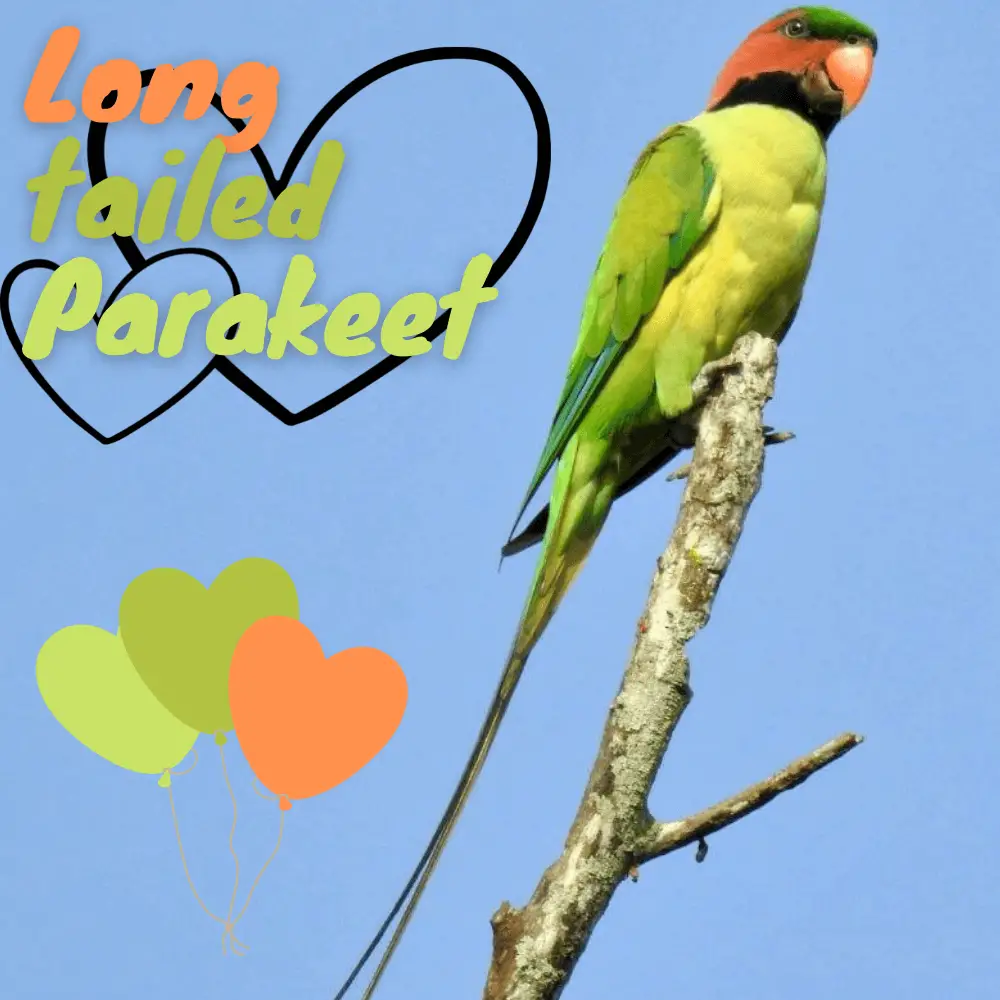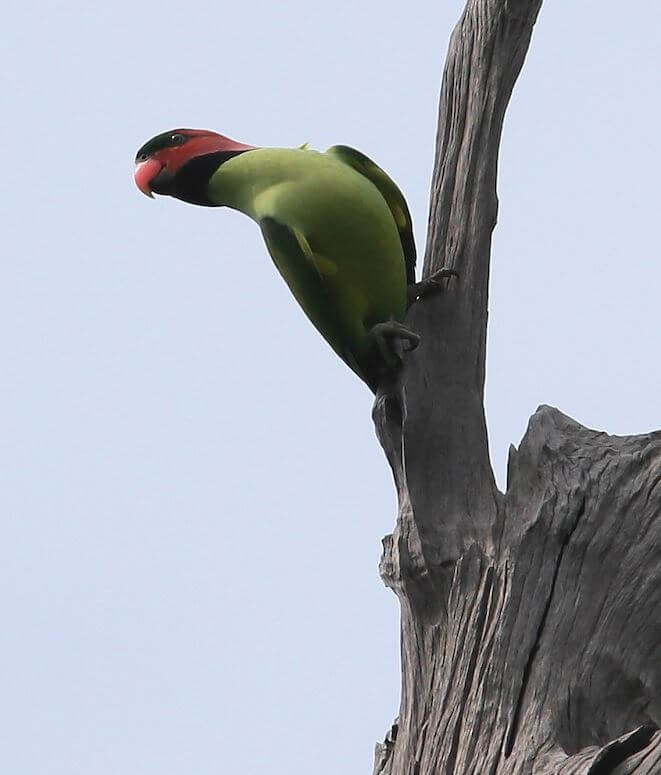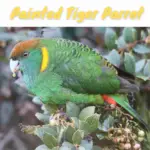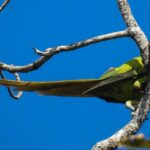
Long tailed Parakeet 40–48 cm; 168–196 g. Upper mandible red, lower blackish red; crown and area above line from cere to eye dark green; the area from the mandible and chin tapering onto lower sides of neck black;
rest of head and nape rose-pink, shading to pale yellowish-green on the mantle and upper back, pale bluish on the lower back, green on upper tail-coverts;
undersides greenish-yellow shading slightly darker on belly; wings green with dull blue on primary-coverts and primaries; tail deep blue centrally, outer feathers green.
Long tailed parakeet female replaces rose-pink on the head with dull orange-red, and blue wash on ear-coverts; bill all brownish.
Immature mainly green, with some orange-red tinge on the sides of the head. Race defontainei has deeper red on the head, yellowish crown;
Modesta crown appears brownish, as feathers dull red mixed with green, duller brownish in female; tytlericrown, nape, mantle and upper back yellowish-green, rump, and lower back green;
nicobarica bright green crown with the yellowish-green nape. The last three races are larger than the first two, nicobarica largest.
Systematics History
Editor’s Note: This article requires further editing work to merge existing content into the appropriate Subspecies sections. Please bear with us while this update takes place.
Forms tytleri and nicobarica differ morphologically and vocally both from each other and from all other races, and may represent two distinct species;
this view is supported by a recent study, which suggested that the current internal taxonomy renders this species polyphyletic. Five subspecies are currently recognized.
Subspecies
Long-tailed Parakeet (Andaman)Psittacula longicauda tytleri Scientific name definitions
P. l. tytleri
Distribution
Long-tailed Parakeet (Nicobar)Psittacula longicauda nicobarica Scientific name definitions
P. l. nicobarica
Distribution
Long-tailed Parakeet (Long-tailed)Psittacula longicauda longicauda/defontainei
P. l. longicauda+1
Distribution
Psittacula longicauda longicauda Scientific name definitions
Distribution
Psittacula longicauda defontainei Scientific name definitions
Distribution
Long-tailed Parakeet (Enggano)Psittacula longicauda Modesta Scientific name definitions
Distribution
Distribution
Editor’s Note: Additional distribution information for this taxon can be found in the ‘Subspecies’ article above. In the future, we will develop a range-wide distribution article.

Habitat
An extreme lowland species, ranging up to 300 m but preferring areas in coastal regions, including mangroves, swamp forest (including peat swamp forest), rain forest edge, partly cleared land, oil-palm plantations, coconut groves.
Movement
Poorly understood fluctuations in numbers occur throughout the range. In some parts of the range, large flocks may build up or suddenly arrive in an area, then the species may be absent for several years.
Certain statements based on a single season or year’s observations may not be reliable. In the Membakut area of Sabah, however, birds reported congregating in large flocks, Sept–Apr.
These observations are consistent with the species being nomadic and/or trap-lining around food resources over huge communal home ranges.
Although once considered on the passage only, Singapore, now judged resident although birds commute across Johor Straits.
Diet and Foraging
Specific items include outer covering of betel nuts Areca catechu, papaya Carica papaya, ripe Pandanus fruit, fruits of Kapor Dryobalanops, Dillenia speciosa, and Sonneratia alba, flowers of Acacia and Bombax, seeds of Macaranga, Ixonanthes, Vitex pubescent, Lagerstroemia, Dipterocarpus crinitus. Can be a pest in oil-palms, plucking ripe fruits to eat the soft mesocarp.
SOURCE: 13seaeagle
Sounds and Vocal Behavior
Flight long tailed parakeet calls a short nasal “yeh” repeated at intervals, but groups in flight may noisily call in unison.
When perched, the repertoire is more varied but predominantly involves nasal screeches and squawks. Voice of race nicobarica said to be gruffer.
Breeding
Generally Dec-May in Malaysia; Jun in Kalimantan; Oct on Sumatra; Feb–Apr in Andamans and Nicobars.
long tailed parakeet Nest in a hole in a tree, in one case adjacent to grass swamp, in another 10 m up in the peat-swamp forest; on Andamans usually in Pterocarpus marsupium, 4–8 m up. Breeds colonially,
with multiple pairs (one count of 16) using neighboring holes in a particular tree or group of trees; 6–20 m up, but on Sumatra once 45 m up in dead limb of Koompassia. Eggs 2–3; in captivity, incubation 24 days.
Conservation Status
VULNERABLE. Previously considered Near Threatened. CITES II. Until recently, very common and widespread in S Kalimantan;
locally common on Sumatra, where however formerly abundant, the decline is linked to loss of breeding sites in the primary forest; locally common in Peninsular Malaysia, where its capacity to survive is linked to its ability to forage outside rainforest and to nest communally.
Occurs in very large numbers in some areas, Brunei. Common, Andamans and Nicobars. International trade was relatively slight, 1981–1985, but in the period 1986–1990, an average of 2143 birds have exported annually, mostly from Malaysia.
Anticipated pest status in oil palm plantations has not been fulfilled, probably because of the inability of birds to breed in such a habitat.
Based on measurements of global forest cover change from 2000 to 2012, it is estimated to have lost almost one-third (32·4%) of its habitat within its distribution over three generations (24·6 years).
SOURCE: ABC’s little world




















